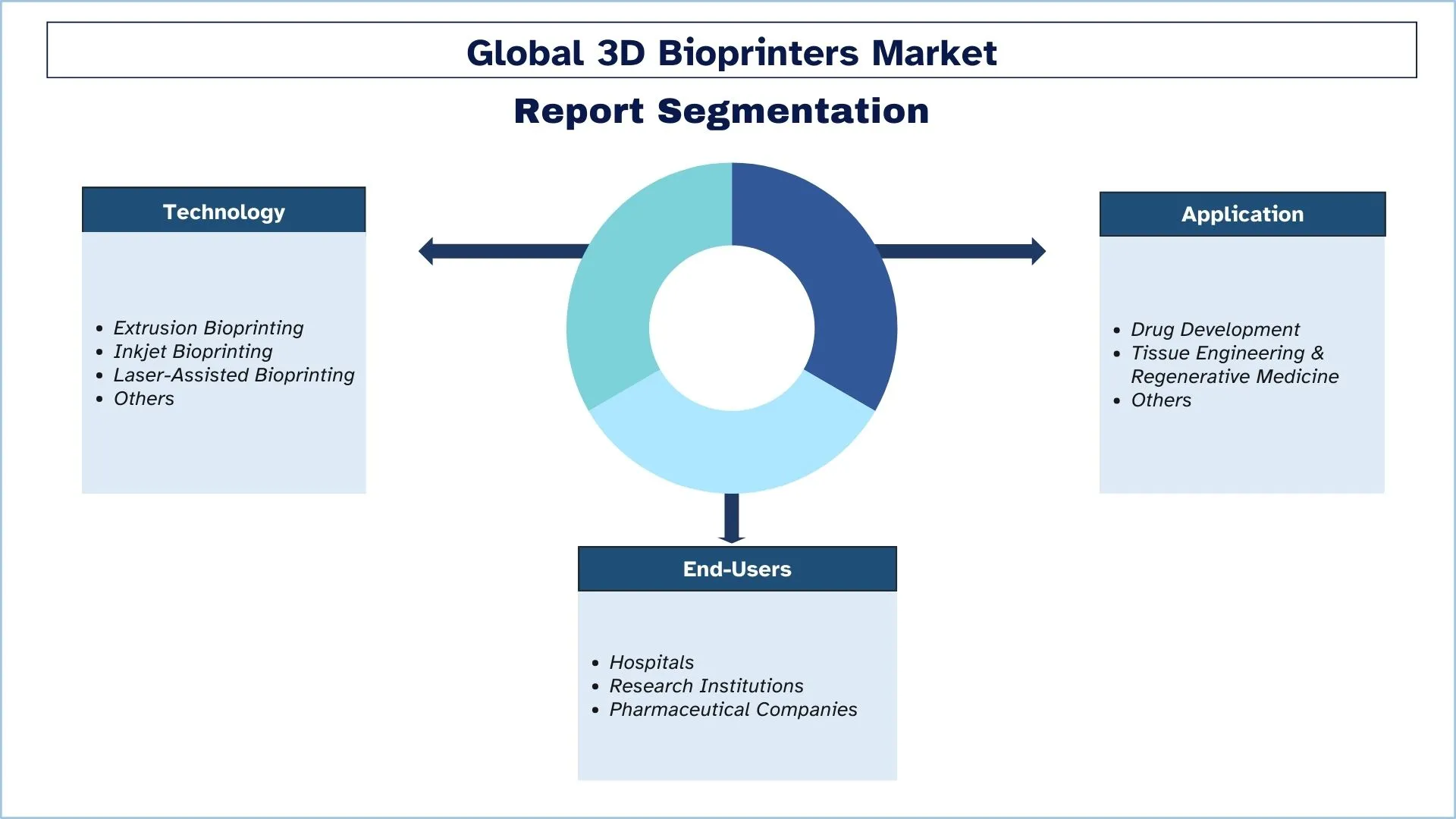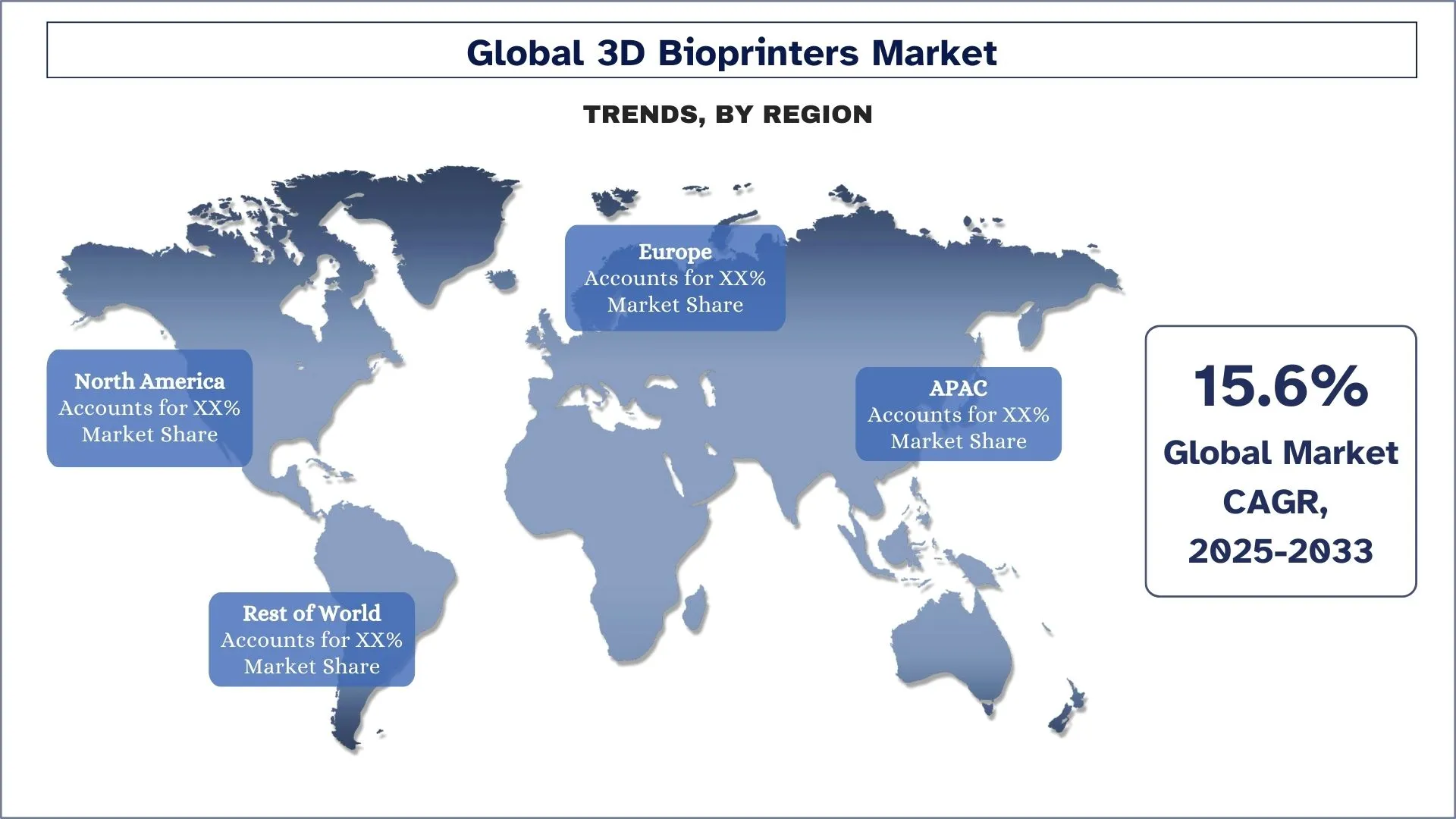
3D 바이오프린터 시장 규모 및 예측
3D 바이오프린터 시장은 2024년에 약 14억 달러로 평가되었으며, 개인 맞춤형 의학에 대한 수요 증가로 인해 예측 기간(2025-2033) 동안 약 15.6%의 상당한 연평균 성장률(CAGR)로 성장할 것으로 예상됩니다.
3D 바이오프린터 시장 분석
글로벌 3D 바이오프린터 시장은 북미, 유럽 및 아시아 태평양 지역을 중심으로 급속한 확장을 보이고 있습니다. 시장은 기술, 최종 사용자 및 응용 분야를 기반으로 세분화되어 3D 바이오프린팅이 제공하는 다양한 가능성을 보여줍니다. 압출, 잉크젯 및 레이저 보조 바이오프린팅과 같은 바이오프린팅 기술의 혁신은 복잡한 조직 및 장기 구조물의 정밀한 제작을 위한 길을 열었습니다. 3D 바이오프린터 시장은 조직 공학, 재생 의학 및 약물 개발의 획기적인 발전에 힘입어 놀라운 성장과 변화를 경험하고 있습니다. 개인 맞춤형 의료 솔루션 및 장기 이식 대안에 대한 수요가 증가함에 따라 3D 바이오프린팅 기술은 의료 분야에서 게임 체인저로 부상하고 있습니다.
생명 공학 회사인 Emulate는 마이크로유체 플랫폼에서 3D 바이오프린팅된 소형 인간 간 모델인 liver-on-a-chip을 도입했습니다. 이러한 발전으로 더 정확하고 효율적인 약물 테스트가 가능해져 동물 모델 의존도를 줄입니다. 3D Systems 및 Stratasys는 생체 적합성 재료 및 고급 3D 바이오프린팅 기술을 사용하여 개인 맞춤형 임플란트 및 보철물을 만드는 데 앞장서고 있습니다. 이러한 맞춤형 임플란트는 환자 결과를 향상시키고 전반적인 삶의 질을 향상시킵니다..
3D 바이오프린터 시장 동향
이 섹션에서는 당사 연구 전문가가 파악한 3D 바이오프린터 시장의 다양한 부문에 영향을 미치는 주요 시장 동향에 대해 논의합니다.
3D 바이오프린팅에서 AI 및 자동화 통합
3D 바이오프린팅의 주요 시장 개발은 정밀도와 재현성을 향상시키는 동시에 효율성을 결정하기 위해 인공 지능과 자동화 시스템을 구현하는 것을 포함합니다. AI 기반 시스템 기술의 조합은 실시간 작동 및 적응형 인쇄를 허용하여 실수를 줄이고 우수한 인쇄된 생물학적 구조를 생성합니다. 자동화 시스템과 머신 러닝 프로그램의 조합은 바이오 잉크 준비부터 조직 성숙까지의 복잡한 절차를 단축하여 조직 공학 및 약물 테스트뿐만 아니라 재생 의학 분야의 연구 활동을 발전시킵니다. 여러 기술 동향은 3D 바이오프린팅을 차세대 의료 개발을 위한 개선되고 확장 가능하며 상업적으로 실용적인 솔루션으로 만들고 있습니다.
3D 바이오프린터 산업 세분화
이 섹션에서는 2025-2033년 동안 글로벌, 지역 및 국가 수준에서 3D 바이오프린터 시장 보고서의 각 부문의 주요 동향에 대한 분석을 제공합니다.
조직 공학 및 재생 의학 시장이 3D 바이오프린터 시장에서 가장 큰 점유율을 차지합니다.
응용 분야별로 시장은 약물 개발, 조직 공학 및 재생 의학 등으로 세분화됩니다. 이 중 조직 공학 및 재생 의학 시장은 2024년 3D 바이오프린터 시장의 대부분의 점유율을 차지했습니다. 조직 공학 및 재생 의학은 이식을 위한 기증 장기 부족에 대한 유망한 솔루션을 제공합니다. 바이오프린팅은 환자의 세포를 사용하여 환자 맞춤형 조직 및 장기를 생성하여 거부 반응 위험을 줄이고 기존 장기 기증자의 필요성을 없앨 수 있습니다.
병원은 3D 바이오프린터 시장보다 더 높은 CAGR을 기록할 것으로 예상됩니다.
최종 사용자를 기준으로 시장은 병원, 연구 기관 및 제약 회사로 세분화됩니다. 연구 기관은 바이오프린팅 분야의 혁신의 핵심 동인입니다. 이들은 조직 공학, 재생 의학 및 질병 모델링에 대한 이해를 발전시키는 데 중점을 둡니다. 3D 바이오프린팅 연구의 경계를 넓힘으로써 이러한 기관은 새로운 바이오프린팅 기술, 재료 및 응용 분야를 개발하는 데 앞장설 수 있습니다.

북미는 2024년 시장에서 상당한 점유율을 차지합니다.
북미는 2024년 3D 바이오프린터 시장을 지배했습니다. 북미는 이 기술의 채택 및 발전을 위한 유리한 환경을 조성하는 여러 요인으로 인해 3D 바이오프린터 시장에서 지속적으로 성장할 것으로 예상되었습니다. 북미의 연구원과 기업은 이식을 위한 복잡한 장기 바이오프린팅을 발전시켰습니다. 기능적 심장 조직 및 간 구조물의 개발은 개인 맞춤형 장기 이식의 가능성을 보여주었습니다. 이 지역의 생명 공학 회사 및 연구 기관은 전임상 약물 테스트를 위해 3D 바이오프린팅된 조직의 사용을 탐구하여 약물 개발 프로세스를 개선하고 동물 실험에 대한 의존도를 줄이는 것을 목표로 합니다.
미국 북미 3D 바이오프린터 시장을 지배합니다.
미국 3D 바이오프린터 시장은 재생 의학, 개인 맞춤형 의료 및 조직 공학 분야의 확산으로 인해 성장 단계에 있습니다. 만성 질환 사례 증가 및 이러한 장기 부족으로 인해 장기 및 조직 제조에 대한 활용도가 높아지고 있습니다. 바이오 잉크, 세포-지지체 복합체 및 고해상도 바이오프린팅 기기의 발전은 기능성이 향상된 조정된 3차원 구조를 이끌고 있습니다. 또한 생명 공학 회사, 연구 센터 및 임상 진료 기관 간의 활발한 협력이 새로운 기술과 응용 분야를 장려합니다. 시장이 발전함에 따라 임상에서 바이오프린팅 솔루션을 채택하는 데 중요한 요인 중 하나는 특정 법적 규정 및 표준 개발의 필요성임을 보여줍니다.

3D 바이오프린터 산업 경쟁 환경
3D 바이오프린터 시장은 여러 글로벌 및 국제적 기업이 경쟁하고 있습니다. 주요 업체들은 파트너십, 계약, 협력, 신제품 출시, 지리적 확장 및 인수 합병과 같은 다양한 성장 전략을 채택하여 시장 입지를 강화하고 있습니다.
최고의 3D 바이오프린터 회사
시장에서 활동하는 주요 업체로는 Organovo Holdings Inc.; BICO; Stratasys; CYFUSE BIOMEDICAL K.K.; REGEMAT 3D SL; Allevi Inc.; Inventia Life Science; Envisiontec US LLC (Desktop Metal); ROKIT HEALTHCARE INC.; GeSim
3D 바이오프린터 시장의 최근 동향
- 2024년 2월BICO Group AB (Cellink)는 DNA Studio 4 Vault, 바이오프린팅 소프트웨어를 출시하여 사용자가 문서에 대한 신뢰를 갖도록 하여 연구실에서 임상으로의 더 빠른 변환을 가능하게 했습니다.
- 2024년 2월Merck KGaA (독일)는 브라질에 2,170만 달러를 투자하여 유통 센터를 설립하여 해당 지역의 Life Science 고객에게 더 빠른 배송을 제공했습니다.
3D 바이오프린터 시장 보고서 범위
세부 정보 | |
기준 연도 | 2024 |
예측 기간 | 2025-2033 |
성장 모멘텀 | 15.6%의 CAGR로 가속화 |
시장 규모 2024 | 14억 달러 |
지역 분석 | 북미, 유럽, 아시아 태평양, 기타 지역 |
주요 기여 지역 | 북미는 예측 기간 동안 가장 높은 CAGR로 성장할 것으로 예상됩니다. |
주요 국가 포함 | 미국, 캐나다, 독일, 프랑스, 영국, 스페인, 이탈리아, 중국, 일본 및 인도 |
Organovo Holdings Inc.; BICO; Stratasys; CYFUSE BIOMEDICAL K.K.; REGEMAT 3D SL; Allevi Inc.; Inventia Life Science; Envisiontec US LLC (Desktop Metal); ROKIT HEALTHCARE INC.; GeSim | |
보고서 범위 | 시장 동향, 동인 및 제약; 매출 추정 및 예측; 세분화 분석; 수요 및 공급 측면 분석; 경쟁 환경; 회사 프로파일링 |
포함된 세그먼트 | 기술별, 응용 분야별, 최종 사용자별, 지역/국가별 |
3D 바이오프린터 시장 보고서를 구매해야 하는 이유:
- 이 연구에는 인증된 주요 업계 전문가가 검증한 시장 규모 및 예측 분석이 포함됩니다.
- 이 보고서는 전체 산업 성과에 대한 간략한 개요를 제공합니다.
- 이 보고서는 주요 비즈니스 재무, 제품 포트폴리오, 확장 전략 및 최근 개발에 중점을 두고 주요 업계 동료에 대한 심층 분석을 포함합니다.
- 업계에서 우세한 동인, 제약, 주요 트렌드 및 기회에 대한 자세한 검토.
- 이 연구는 다양한 세그먼트에 걸쳐 시장을 포괄적으로 다룹니다.
- 산업에 대한 심층적인 지역별 분석.
사용자 정의 옵션:
글로벌 3D 바이오프린터 시장은 요구 사항 또는 다른 시장 세그먼트에 따라 추가로 맞춤화할 수 있습니다. 이 외에도 UnivDatos는 귀하가 자체 비즈니스 요구 사항을 가질 수 있음을 이해합니다. 따라서 귀하의 요구 사항에 완벽하게 맞는 보고서를 얻으려면 언제든지 문의하십시오.
목차
3D 바이오프린터 시장 분석(2023-2033) 연구 방법론
우리는 과거 시장을 분석하고, 현재 시장을 추정했으며, 전 세계 주요 지역에서 적용하기 위해 글로벌 3D 바이오프린터 시장의 미래 시장을 예측했습니다. 과거 시장 데이터를 수집하고 현재 시장 규모를 추정하기 위해 포괄적인 2차 연구를 수행했습니다. 이러한 통찰력을 검증하기 위해 수많은 결과와 가정을 신중하게 검토했습니다. 또한 3D 바이오프린터 가치 사슬 전반에 걸쳐 업계 전문가와의 심층적인 1차 인터뷰를 진행했습니다. 이러한 인터뷰를 통해 시장 수치를 검증한 후, 상향식 및 하향식 접근 방식을 사용하여 전체 시장 규모를 예측했습니다. 그런 다음 시장 세분화 및 데이터 삼각 측량 방법을 사용하여 산업 세그먼트 및 하위 세그먼트의 시장 규모를 추정하고 분석했습니다.
시장 엔지니어링
데이터 삼각 측량 기법을 사용하여 전체 시장 추정을 마무리하고 글로벌 3D 바이오프린터 시장의 각 세그먼트 및 하위 세그먼트에 대한 정확한 통계 수치를 도출했습니다. 기술, 응용 분야, 최종 사용자 및 글로벌 3D 바이오프린터 시장 내 지역을 포함한 다양한 매개변수와 트렌드를 분석하여 데이터를 여러 세그먼트 및 하위 세그먼트로 나눴습니다.
글로벌 3D 바이오프린터 시장 연구의 주요 목표는
이 연구는 글로벌 3D 바이오프린터 시장의 현재 및 미래 트렌드를 파악하여 투자자에게 전략적 통찰력을 제공합니다. 이는 지역 시장 매력을 강조하여 업계 참여자가 아직 개척되지 않은 시장을 공략하고 선두 주자 이점을 얻을 수 있도록 합니다. 연구의 다른 정량적 목표는 다음과 같습니다.
- 시장 규모 분석:가치(USD) 측면에서 글로벌 3D 바이오프린터 시장과 해당 세그먼트의 현재 및 예측 시장 규모를 평가합니다.
- 3D 바이오프린터 시장 세분화:이 연구는 기술, 응용 분야, 최종 사용자 및 지역별로 시장을 세분화합니다.
- 규제 프레임워크 및 가치 사슬 분석:3D 바이오프린터 산업의 규제 프레임워크, 가치 사슬, 고객 행동 및 경쟁 환경을 조사합니다.
- 지역 분석:아시아 태평양, 유럽, 북미 및 기타 지역과 같은 주요 지역에 대한 자세한 지역 분석을 수행합니다.
- 회사 프로필 및 성장 전략:3D 바이오프린터 시장의 회사 프로필과 빠르게 성장하는 시장을 유지하기 위해 시장 선두 주자가 채택한 성장 전략.
자주 묻는 질문 자주 묻는 질문
Q1: 3D 바이오프린터 시장의 현재 규모와 성장 잠재력은 무엇인가?
2024년 현재, 글로벌 3D 바이오프린터 시장은 약 14억 달러 규모로 평가되며, 기술 발전과 의료 응용 분야의 증가에 힘입어 2033년까지 연평균 성장률(CAGR) 15.6%로 성장할 것으로 예상됩니다.
Q2: 3D 바이오프린터 시장 성장의 원동력은 무엇인가?
맞춤형 의학 및 조직 공학에 대한 수요 증가로 인해 3D 바이오프린터 채택이 촉진되어, 인간 조직 및 장기 모델의 정밀한 제작이 가능해지고 있습니다.
Q3: 최종 사용자별로 3D 바이오프린터 시장에서 가장 큰 점유율을 차지하는 부문은?
현재 병원 부문이 최종 사용자 부문에서 가장 큰 시장 점유율을 차지하고 있습니다.
Q4: 3D 바이오프린터 시장의 주요 트렌드는 무엇인가?
AI 및 고급 생체 재료의 3D 바이오프린팅 기술 통합은 재생 의학 및 제약 연구에서 인쇄 정밀도, 확장성 및 응용을 향상시키고 있습니다.
Q5: 어떤 지역이 3D 바이오프린터 시장을 지배할 것인가?
북미 지역이 글로벌 3D 바이오프린터 시장을 선도하고 있습니다.
Q6: 3D 바이오프린터 시장의 가장 큰 과제는 무엇인가?
3D 바이오프린터 솔루션의 광범위한 상업적 채택 및 확장성을 지속적으로 제한하는 요인으로, 높은 비용, 규제 장벽, 그리고 바이오 잉크 제제의 제한된 표준화가 있습니다.
Q7: 글로벌 3D 바이오프린터 시장의 주요 기업은 누구입니까?
3D 바이오프린터 혁신을 주도하는 주요 기업은 다음과 같습니다:
• Organovo Holdings Inc.
• BICO
• Stratasys
• CYFUSE BIOMEDICAL K.K.
• REGEMAT 3D SL
• Allevi Inc. (3D Systems)
• Inventia Life Science
• Envisiontec US LLC (Desktop Metal)
• ROKIT HEALTHCARE INC.
• GeSim
Q8: 미국 3D 바이오프린터 시장의 주요 투자 기회는 무엇입니까?
투자 기회는 첨단 바이오프린터 기술, 확장 가능한 바이오 잉크 솔루션, 그리고 재생 의학, 오가노이드 모델, 제약 테스트에 초점을 맞춘 파트너십에 있습니다. R&D 및 IP 개발에 대한 초기 투자는 장기적인 전략적 가치를 제공합니다.
Q9: 기업은 진화하는 3D 바이오프린팅 환경에서 어떻게 경쟁 우위를 확보할 수 있습니까?
경쟁력을 유지하기 위해, 기업은 혁신을 우선시하고, 연구 기관과의 전략적 협력을 확보하며, 규제 준비에 집중하고, 확장 가능한 제조 및 맞춤형 제작 역량에 투자해야 합니다.
관련 보고서
이 상품을 구매한 고객님들도 함께 구매하신 상품










